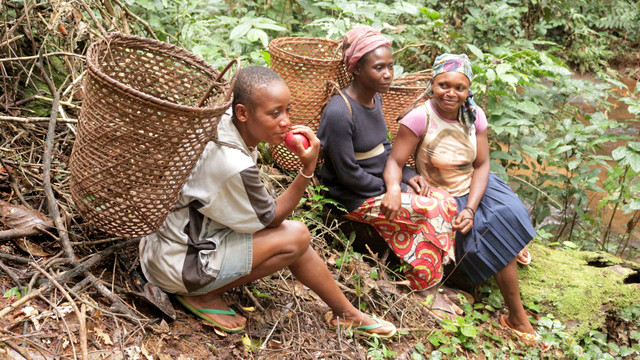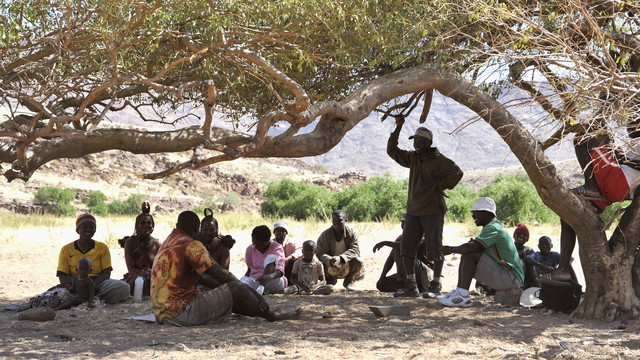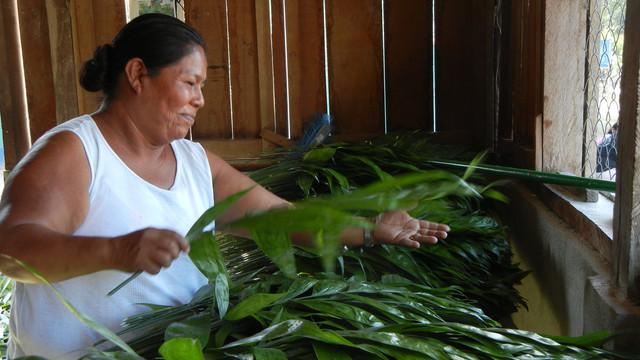Three ‘E’s to guide the post-2020 biodiversity roadmap
Joji Cariño sets out three key principles that could underpin a new biodiversity deal where humans and nature work in harmony – and explains why indigenous peoples and local communities will be key in shaping this deal.


Indigenous women in Bangladesh's Lawachara National Park collecting wood for building (Photo: Fabian Lambeck, CC BY-SA 4.0)
The upcoming UN Biodiversity Conference (Convention on Biological Diversity COP14) will mark a crucial stepping stone towards the landmark 2020 ’biodiversity moment’. The November meeting begins the two-year countdown to Beijing when more than 190 countries will adopt the post-2020 global biodiversity roadmap, setting the world on a path towards a 2050 vision of living in harmony with nature.
There is growing global recognition that urgent action is needed to protect biodiversity – so it’s crucial we get the post-2020 framework right.
Three key ‘E’s
Working to three core principles will give us our best chance of reaching an agreement that is both ambitious and achievable:
- Envision: imagine as a future possibility; visualise
- Embed: fix something firmly into a substance
- Everyday life: ways in which people typically act, think, and feel on a daily basis; habitual
But how can these dictionary definitions help us secure a future where targets for human development and protecting nature work in harmony?
Let’s take diverse food systems as a case in point. The Intergovernmental Science-Policy Platform on Biodiversity and Ecosystem Services (IPBES) has been conducting scenario-building workshops as part of a process of developing ‘Multiscale scenarios for nature futures’. Links between targets for human development and targets for nature are often overlooked; these scenarios help to make that link.
I participated in one of the workshops held in Auckland, New Zealand that envisioned a ‘Tasty World with Values’. This is a world where human-nature relations are based on reciprocity, harmony and relationality supported by educational systems infused by these values; food is predominantly produced in bioculturally diverse local food systems and strong cultural institutions ensure respectful sharing among diverse knowledge systems and governance systems.
Food systems are part of peoples’ everyday lives, but mainstream production and consumption patterns are contributing to unhealthy and unsustainable living. Urgently needed are food policies that envision biodiverse food cultures and futures. Social learning spaces are crucial for embedding this vision in practical actions in communities, schools, workplaces, government legislation and corporate boardrooms.
The role of indigenous peoples and local communities
Indigenous peoples and local communities have a wealth of traditional knowledge, expertise and practices that can sustainably protect and conserve biodiversity.
The numbers speak volumes:
- 80% of terrestrial biological diversity is found on indigenous peoples’ land
- 95% of the world’s languages are spoken by small populations of indigenous peoples
- 300,000 million metric tons of carbon is absorbed in their trees and soil – equalling 33 times global energy emissions in 2017, and
- In the Amazon, deforestation is between two and six times lower in areas where indigenous peoples have land rights, a trend seen in other countries including Bolivia, Guatemala, Mexico, Nepal, Indonesia, Niger and Tanzania.
Their strong stewardship of nature is evident; providing support to ensure their contributions are heard and acted on would mark real progress in achieving the biodiversity goals.
Diversity within these societies also needs to be understood, with due attention given to the distinct roles played by women and men, elders and youth – thereby valuing the individual and collective rights and responsibilities of all community members.
Harnessing local energy
International policymaking is slowly recognising indigenous peoples and local communities as stewards of biodiversity, but more needs to be done to ensure their voices are heard and their views represented.
The transformative potential of the post-2020 biodiversity framework including synergies with the Sustainable Development Goals and the Paris Agreement needs to build on the creative energies, disruptive knowledge and innovative solutions of these direct custodians of biodiversity who have deep and abiding cultural and spiritual relationships with ancestral territories and the ecosystems that support them.
Case studies of collective action show that drawing on the full breadth of experience and knowledge of all community members creates a virtuous circle of solidarity and learning that leads to positive change.
Persisting and surviving in the margins of dominant institutions, indigenous peoples and local communities are also leaders in understanding systemic problems and are supreme innovators and problem-solvers, including adapting global commitments into viable local solutions.
It is crucial that the contributions of these groups are heard at COP14. The Nature and Culture Summit will bring together participants from around the world to reflect on synergies between biological and cultural diversity, and between science and indigenous knowledge systems.
It will seek to raise awareness of how traditional knowledge can help tackle biodiversity collapse as one of the 21st century’s deepest global crises – and show the significant role of indigenous peoples and local communities in envisioning and embedding living in harmony with nature in our everyday lives.



